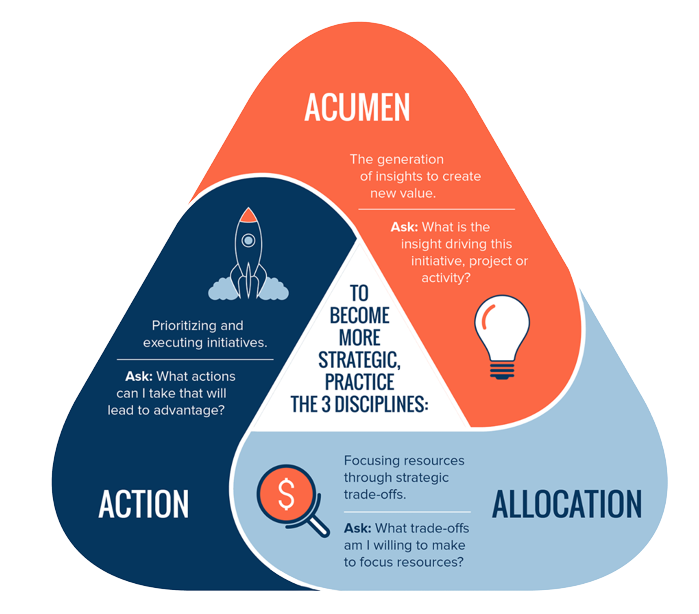Here’s something you’ll never hear in business: “Let’s promote her to a senior leadership role…she’s highly tactical.” The greatest compliment a leader can receive is to be referred to as “strategic.” A survey of more than 10,000 senior executives showed that 97 percent believe the leadership behavior most critical to an organization’s future success is being “strategic.” Additional research with more than 60,000 executives around the world found that a strategic approach to leadership was 10 times more important to the perception of effectiveness than any other factor studied.
Business leaders, academicians, and boards of directors echo these findings:
“To me, the single most important skill needed for any CEO today is strategic acuity.” Indra Nooyi, former CEO, Pepsi.
“After two decades of observation, it is clear that mastery of strategy is not an innate skill. Most great CEOs learn how to become better strategic thinkers.” David Yoffie, professor, Harvard Business School and Michael Cusumano professor, MIT Sloan School of Management.
“The #1 trait of active CEOs that make them attractive board candidates is strategic expertise.” Corporate Board of Directors Survey
The No. 1 capability boards are looking for in a CEO: Strategic capability. Cathy Anterasian, Senior Partner, Spencer Stuart.
As the research and thought leaders demonstrate, the importance of being strategic is universal. So, what does “strategic” actually mean? Merriam-Webster dictionary’s primary definition of the term “strategic” is: “of, relating to, or marked by strategy.” Since that’s about as helpful as an umbrella in a hurricane, I’d like to share the following definition:
Strategic: Possessing insight that leads to advantage.
We can break this definition of strategic down into its’ two core elements: insight and advantage. An insight is when you combine two or more pieces of information or data in a unique way to come up with a new approach, new offering, or new solution that moves the business forward. Simply put, an insight is a learning that leads to new value. Advantage is inherently an element of strategy. It commonly refers to a desired end in the form of gain, profit, benefit, or position of superiority.
When we use this definition of strategic, it helps us clarify what is and is not strategic. A person, or plan can be strategic because both have the potential to possess insight that leads to advantage. The word strategic is plastered in front of a lot of other words to make them sound important, but their meanings don’t hold up. Phrases such as “strategic objective” or “strategic imperative” are examples of terms that sound proper
but don’t pass the test of being able to house and leverage learnings. Eliminate the overuse of the term “strategic” and you’ll clarify and simplify communication amongst your team.
The Strategic Quotientä is a measure of your strategic capabilities as exhibited through your mindset and behaviors. Your strategic capabilities consist of how you think, plan, and act strategically. The good news is that each of these areas of being strategic can be developed and improved with deliberate practice. If IQ gets you hired, and EQ gets you promoted, then SQ gets you to the C-suite.
The first step on the path to fulfilling your strategic potential is to understand where you are today. I developed the Strategic Quotient (SQ) to help you determine exactly that—your baseline strategic capabilities. The SQ Assessment is based on more than 20 years of research and uses the 3A Framework of the three critical disciplines for being strategic. These three disciplines are:
· Acumen (Thinking) – The generation of insights to create new value.
· Allocation (Planning) – Focusing resources through strategic trade-offs.
· Action (Acting) – Prioritizing and executing initiatives.

The SQ is used to identify opportunities for development of a person’s strategic capabilities, and, following a targeted intervention, to determine whether the individual understands and applies the disciplines of Acumen, Allocation, and Action. A person’s score on the SQ may indicate the likelihood they can successfully apply and demonstrate these strategic capabilities.
Primary and Secondary Dimensions of the Strategic Quotient

The SQ Assessment is comprised of 50 statements to determine the performance level of how one thinks, plans, and acts strategically. Here are five sample statements from the SQ Assessment:

Are you strategic? Take the assessment today and find out. After all, in today’s competitive business arena, it’s be strategic…or be gone.
